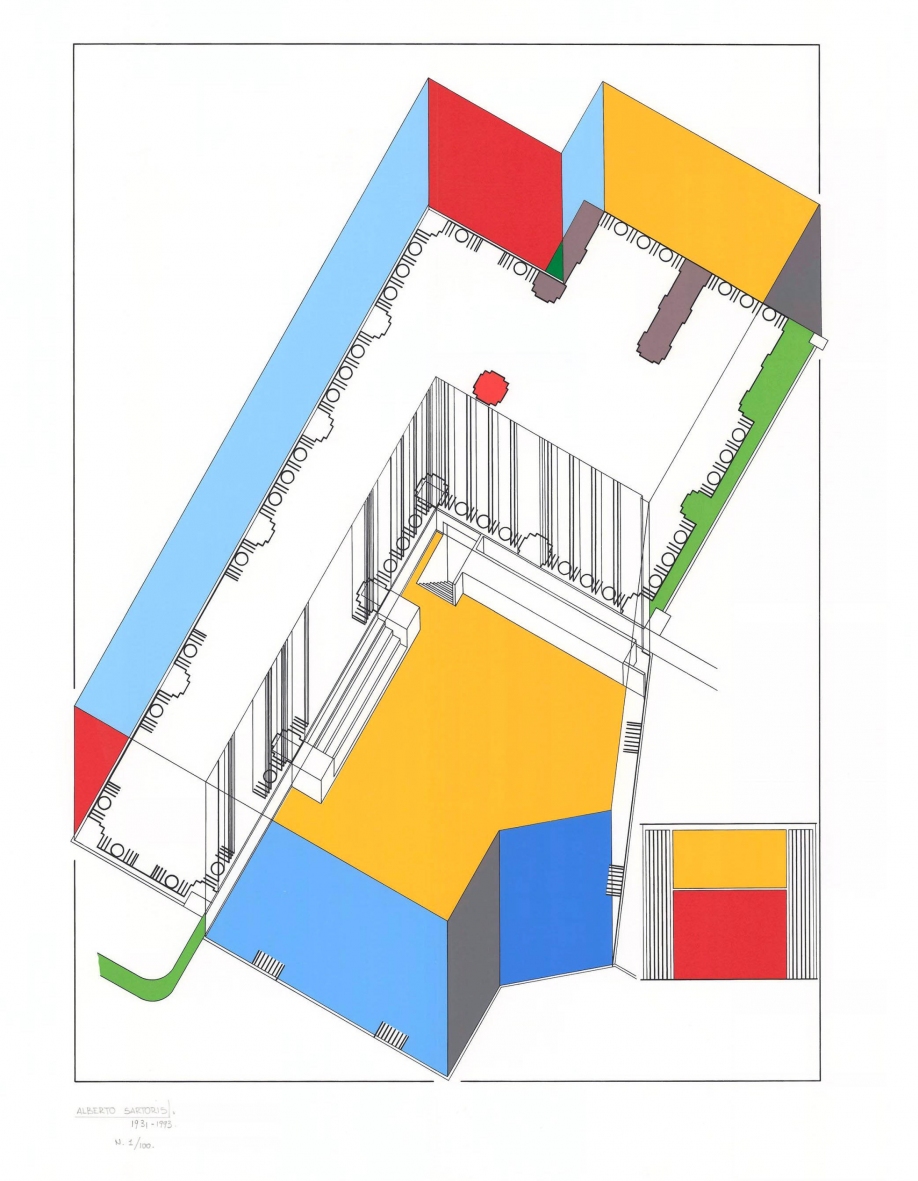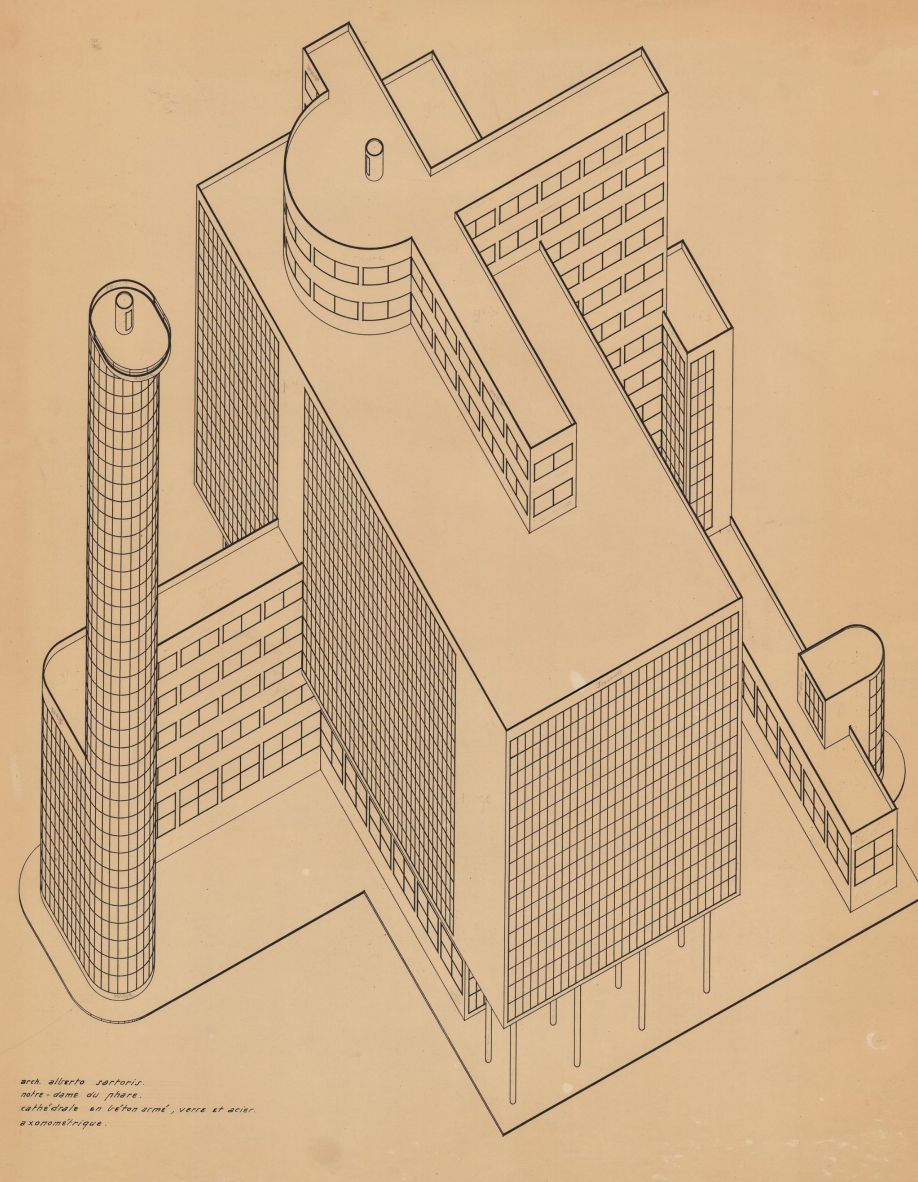Alberto Sartoris
Anthology of drawings by architect Alberto Sartoris to be shown by EPFL in Rome
From 10 October to 10 November 2019, EPFL’s Archives of Modern Construction will exhibit around 100 drawings by avant-garde architect Alberto Sartoris at Rome’s Casa dell’Architettura. Entitled “La macchina delle meraviglie” (“The machine of marvels”), the exhibition shows Sartoris’ desire to elevate architectural drawings into an art form. The event is also an opportunity to highlight the strong cultural ties between Switzerland and Italy.
In addition to being a key figure in the development of modern architecture, Alberto Sartoris produced drawings throughout his life. The care he took over his architectural drawings and the importance he gave to details and perspective show his desire to fill the viewer with wonder. That provided the inspiration for EPFL’s Archives of Modern Construction to put together a retrospective of the architect’s work, comprising 103 of his drawings dating from his time as a trainee in the 1920s to the end of the 1930s, along with 13 color screen prints produced between the 1970s and the 1990s.
This one-off exhibition, called “La macchina delle meraviglie. L’arte del disegno nell’opera di Alberto Sartoris” (“The machine of marvels. The art of drawing in the work of Alberto Sartoris”), will take place at Rome’s Casa dell’Architettura. It is a rare opportunity to give international exposure to an important collection held at EPFL, and thereby to promote Switzerland’s cultural heritage beyond its borders.
Alberto Sartoris was born in Turin in 1901 and grew up in Geneva, where he attended the Ecole des Beaux-Arts. In the 1920s, having moved back to Turin, he took an interest in avant-garde art movements and became close to the Futurists. After helping to found the International Congresses of Modern Architecture in La Sarraz in 1928, he settled in the Lausanne region. He became one of the main architects of the Modern Movement, involved in the practice, theoretical development and promotion of modern art.
Invention through drawing
His undeniable graphical mastery was based on a precise philosophy inspired by humanism. For Sartoris, architectural drawings were an art form in their own right, a manifestation of an idea taking shape – they must be considered and planned with great precision before being executed. Sartoris’ drawings are thus manifestos of his thoughts, or, as he liked to say, “graphic designs intended to produce architectural inventions.” In the 1970s and 1980s, Sartoris’ artistic ambitions took on a new form with the production of hundreds of screen prints based on his earliest drawings. Some of these prints will be shown in the new exhibition, presenting viewers with a thought-provoking contrast with today’s standardized digital templates.
Parallel events
The EPFL exhibition will form part of the inaugural Rome Architecture Week (“Settimana del progetto di architettura nel mondo”), taking place between 10 and 18 November. This international festival, supported by Rome’s guild of architects, aims to focus attention on the importance of architecture at a time of urban, social and economic transformation in today’s major cities. As part of the festival, the Casa dell’Architettura will also host an exhibition of Italian design and an exhibition on Italian architect Francesco Berarducci, along with lectures and workshops.
Exhibition details “La macchina delle meraviglie,” 10 October to 10 November 2019, Casa dell’Architettura, Piazza Manfredo Fanti 47, Rome.
Alberto Sartoris: key dates
Born in Turin in 1901. Moved with his family to Geneva at an early age.
Grew up and educated in Geneva. Vocational school, around 1915–1916. Fine arts school, 1916–1919.
Moved to Turin in 1922. Worked in Annibale Rigotti’s practice, around 1922–1926. First projects and publications. Came into contact with many Italian artists and architects and took an interest in avant-garde art movements. Took part in many exhibitions, as exhibiting artist or curator, in Switzerland and Italy.
In 1928, co-founded the International Congresses of Modern Architecture, in La Sarraz.
In 1928–1929, moved back to French-speaking Switzerland, first to Geneva, then to the Lavaux region and, in 1976, to Cossonay.
In the late 1920s and 1930s, helped promote avant-garde artistic and architectural ideas (particularly as part of the Modern Movement) and formed many connections with various movements in Italy and elsewhere in Europe.
Author of many publications, the best known of which are “Elements of Functional Architecture” (first edition 1932) and the three volumes of “Encyclopedia of the New Architecture” (1948–1957).
Honorary doctorates from EPFL in 1976, the Polytechnic University of Turin in 1989 and the University of La Laguna (Spain) in 1992. Taught history of urban planning at EPFL from 1976 onwards.
Died in Pompaples in 1998.
Notable buildings
Lourtier church (1932), the Morand-Pasteur house in Saillon (1934), the Circle of the Hermitage in Epesses (1935), and the house and workshop of painters Italo and Vincent De Grandi in Corseaux (1939).

